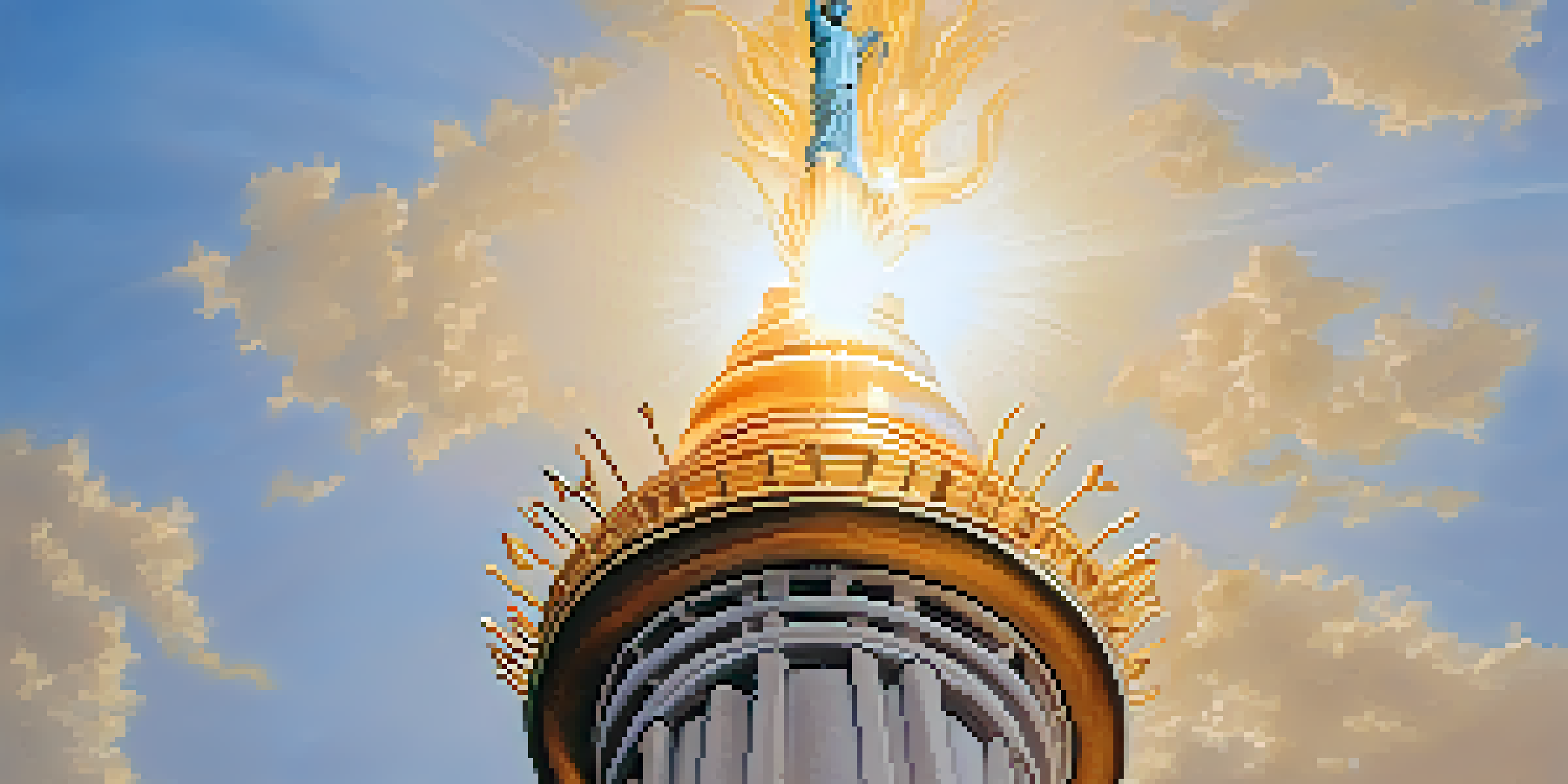The Statue of Liberty: Symbol of Freedom and Immigrant Dreams

The History Behind the Statue of Liberty's Creation
The Statue of Liberty was a gift from France to the United States, symbolizing friendship and shared ideals. Designed by French sculptor Frédéric Auguste Bartholdi, its construction began in 1875 and took over a decade to complete. The statue was dedicated on October 28, 1886, and has since become a powerful emblem of liberty.
Give me your tired, your poor, your huddled masses yearning to breathe free.
Originally named 'Liberty Enlightening the World,' the statue stands at an impressive 151 feet tall, with its pedestal adding another 154 feet. This towering figure was designed to represent freedom from oppression, which resonated deeply with the values held by both nations. The statue's copper exterior has developed a green patina over the years, adding to its charm and historical significance.
The Statue of Liberty was not only a gift but also a message of hope to immigrants arriving in America. It was strategically placed at the entrance of New York Harbor, welcoming millions as they embarked on their journey toward a new life. This iconic structure quickly became synonymous with the American Dream.
Symbolism: More Than Just a Statue
The Statue of Liberty is rich in symbolism, from her torch to her crown. The torch represents enlightenment, guiding those seeking freedom and knowledge, while her seven spikes symbolize the seven continents, indicating that liberty should be universal. Each element of the statue encourages hope and aspiration.

Her broken chains at her feet signify the freedom from oppression and the shackles of tyranny. This powerful imagery serves as a reminder of the struggles many faced to achieve their freedom, making the statue a poignant symbol of resilience and hope. It's not just a statue; it's a representation of the triumph of the human spirit.
Symbol of Freedom and Hope
The Statue of Liberty serves as a powerful emblem of liberty and hope for immigrants seeking a new life in America.
Moreover, the inscription on the pedestal, 'Give me your tired, your poor, your huddled masses yearning to breathe free,' echoes the dreams of countless immigrants. This message has turned the statue into a beacon for those seeking refuge and a better life, fostering a sense of belonging and acceptance.
The Statue's Role in American History
Throughout history, the Statue of Liberty has played a significant role in America's national identity. It has stood as a testament to the values of democracy, freedom, and justice, especially during times of conflict. Even during World War II, the statue remained a symbol of hope for soldiers and civilians alike.
Liberty is the mother of all things.
In the 20th century, the statue was a focal point during the civil rights movement, representing the fight for equality and justice. Activists often referenced Lady Liberty in their speeches, aligning their cause with the ideals she represents. This connection has solidified her place in American history as a symbol of progress.
In more recent times, the statue has become a site for various movements advocating for immigrant rights. As debates surrounding immigration continue to evolve, Lady Liberty stands steadfast, inspiring countless individuals to fight for their dreams. Her presence reminds us that the pursuit of freedom is a journey worth taking.
Cultural Impact: The Statue in Art and Literature
The Statue of Liberty has inspired countless works of art, literature, and music over the years. Artists have captured her image in various forms, from paintings to photographs, celebrating her stature as a cultural icon. She has appeared in everything from political cartoons to blockbuster films, showcasing her influence on popular culture.
In literature, the statue has been referenced in numerous poems and novels, often symbolizing hope and freedom. Famous poet Emma Lazarus famously wrote 'The New Colossus,' which celebrates the statue as a welcoming mother to immigrants. This piece has solidified her role as a literary symbol of acceptance.
Cultural and Historical Impact
Throughout American history, the statue has represented ideals of democracy, resilience, and the ongoing fight for equality.
Moreover, her image has been used in political discourse to highlight issues related to immigration and human rights. The statue’s silhouette serves as a powerful reminder of the ideals America strives to uphold, encouraging artists and writers to continue telling stories of resilience and hope.
Tourism and the Statue of Liberty Today
Today, the Statue of Liberty is one of the most visited monuments in the world, attracting millions of tourists each year. Visitors can take a ferry to Liberty Island, where they can explore the statue up close and learn about its history in the museum. This experience allows people to connect with the statue on a personal level, deepening their appreciation for its significance.
Tourism has helped maintain the statue's presence in the public consciousness, ensuring that its message of freedom and hope continues to resonate. Guided tours often emphasize the importance of the statue as a symbol of immigration, allowing visitors to understand the dreams and aspirations it represents. It's a journey that many find deeply moving.
In recent years, efforts have been made to enhance visitor experience while preserving the statue's integrity. Educational programs and events celebrate the statue's legacy, engaging the community in discussions about freedom and human rights. This commitment ensures that the Statue of Liberty remains a vibrant part of America's cultural landscape.
Preservation Efforts for the Statue of Liberty
Preserving the Statue of Liberty is crucial to maintaining its status as a national monument. Over the years, various restoration projects have been undertaken to address the effects of weathering and pollution on the statue’s copper surface. These efforts ensure that Lady Liberty remains in good condition for future generations to admire and appreciate.
One significant restoration project took place in the 1980s when the statue was closed to the public for extensive repairs. This involved replacing the original torch with a replica, preserving the original for display in the museum. Such initiatives highlight the importance of maintaining the statue's integrity while honoring its historical significance.
Preservation for Future Generations
Ongoing restoration and educational efforts ensure that the Statue of Liberty remains a vital symbol of freedom for future generations.
In addition to physical preservation, education plays a key role in safeguarding the statue’s legacy. Organizations work tirelessly to raise awareness about the statue's history and its importance as a symbol of freedom. Through educational programs and outreach, they inspire future generations to cherish and uphold the values the statue represents.
The Statue of Liberty's Legacy and Future
As we look to the future, the Statue of Liberty's legacy will continue to inspire individuals around the world. Her message of freedom, hope, and acceptance remains relevant in today's society, especially as conversations around immigration and human rights persist. The statue serves as a reminder that the pursuit of liberty is an ongoing journey.
With each passing year, more people discover her story and the dreams she symbolizes. As new generations visit her, they carry forward the ideals she embodies, ensuring that her message remains alive. The statue will forever hold a special place in the hearts of those who believe in the promise of a better tomorrow.

Ultimately, the Statue of Liberty will continue to stand tall as a beacon of hope, guiding individuals toward their dreams. As long as there are those yearning for freedom, Lady Liberty will remain a powerful symbol of the enduring human spirit and the quest for a brighter future.